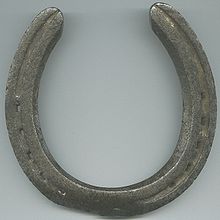
Back Hoefyster Afrikaans Ferradura AN Ikpukot inyinya ANN حدوة Arabic Nal Azerbaijani Падкова Byelorussian Подкова Bulgarian Houarn-marc'h Breton Ferradura Catalan Podkova Czech
This article needs additional citations for verification. (April 2017) |


A horseshoe is a product designed to protect a horse hoof from wear. Shoes are attached on the palmar surface (ground side) of the hooves, usually nailed through the insensitive hoof wall that is anatomically akin to the human toenail, although much larger and thicker. However, there are also cases where shoes are glued.
Horseshoes are available in a wide variety of materials and styles, developed for different types of horses and for the work they do. The most common materials are steel and aluminium, but specialized shoes may include use of rubber, plastic, magnesium, titanium, or copper.[1] Steel tends to be preferred in sports in which a strong, long-wearing shoe is needed, such as polo, eventing, show jumping, and western riding events. Aluminium shoes are lighter, making them common in horse racing where a lighter shoe is desired, and often facilitate certain types of movement; they are often favored in the discipline of dressage.[2] Some horseshoes have "caulkins", "caulks", or "calks": protrusions at the toe or heels of the shoe, or both, to provide additional traction.
The fitting of horseshoes is a professional occupation, conducted by a farrier, who specializes in the preparation of feet, assessing potential lameness issues, and fitting appropriate shoes, including remedial features where required. In some countries, such as the UK, horseshoeing is legally restricted to people with specific qualifications and experience. In others, such as the United States, where professional licensing is not legally required, professional organizations provide certification programs that publicly identify qualified individuals.
When kept as a talisman, a horseshoe is said to bring good luck.[3] A stylized variation of the horseshoe is used for a popular throwing game, horseshoes.
- ^ Price, Steven D. (ed.) The Whole Horse Catalog: Revised and Updated New York:Fireside 1998 ISBN 0-684-83995-4, pp. 84–87.
- ^ Evans, J. Warren, et al. The Horse. Second edition, New York: Freeman, 1990, ISBN 0-7167-1811-1, pp. 731–739.
- ^ Smith, Lindi (18 January 2019). "The Legend Behind Horseshoes For Good Luck Involves The Devil Himself". Wide Open Country. Retrieved 13 August 2019.